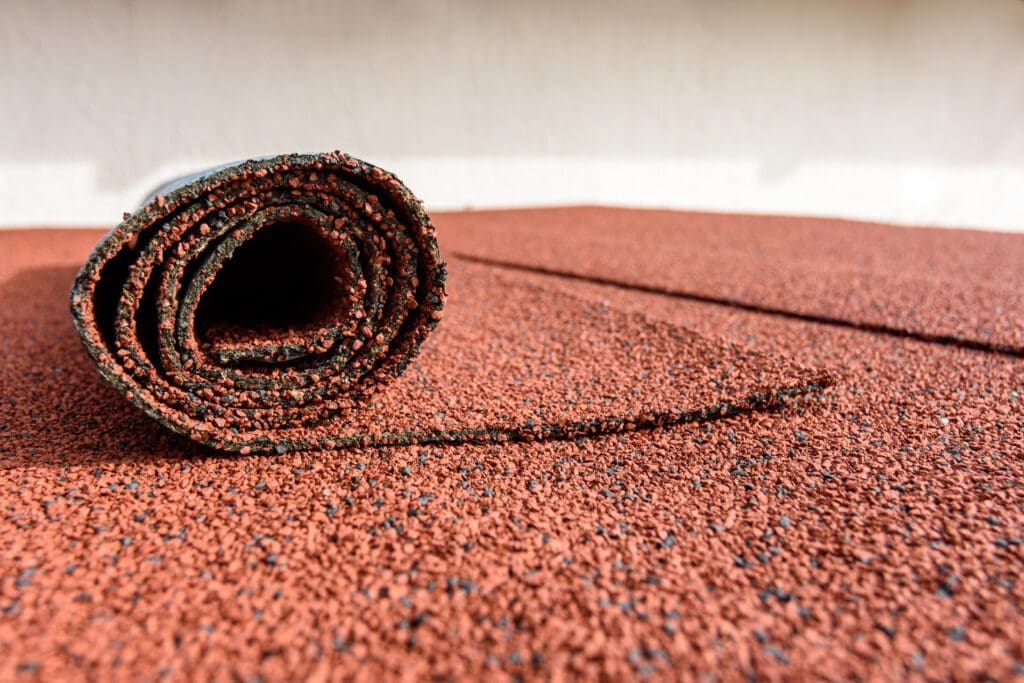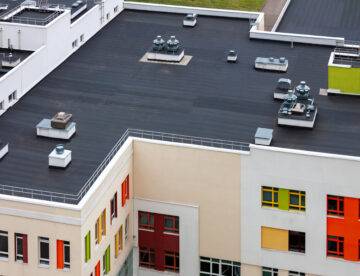Sometimes the budget rules, but you still need to get the projects done. Those are the times when products like roll roofing, also known as rolled roofing, might seem like a good idea. So let’s take closer look at rolled roofing. What is rolled roofing? And is rolled roofing cheaper than shingles?
What Is Rolled Roofing?
Rolled roofing is similar to asphalt shingles, in that it’s been around for decades, and it’s made of similar materials. And yes, rolled roofing is cheaper than shingles. It’s usually been an asphalt-based product consisting of heavy felt saturated with asphalt, then coated with ceramic granules. The granules are there for appearance, as they give the roll its color. They also add to the lifespan of the product, as they provide some impact resistance and UV resistance. Rolled roofing is not the same as tar paper. It’s substantially heavier, and it has the layer of granules that provide some weather resistance.
As with shingles, some changes and improvements have come down the line over the years. Rolled roofing may use a synthetic or fiberglass mat these days. Those products tend to be an improvement over the old-school saturated felt, if more expensive. Generally, these products end up looking almost exactly the same as the old-school asphalt roll roofing though, so you’re not getting that nice appearance upgrade like you get when you go from three-tab to architectural shingles.
You’ll find rolled roofing packaged as a roll–yes, no kidding–of about 3 feet wide by about 35–36′ long. That makes it about 100 square feet, or a square, as the roofing industry uses. That roll is roughly equivalent to a package of asphalt shingles, so it’s easy to compare prices. As for lifespan, you’ll get 5–15 years from rolled roofing, so it’s on the shorter end. But it is low cost and it does go on fast.
Where to Use Rolled Roofing
Rolled roofing is suitable for low-slope roofs, but it’s not the same as a torch-down roof. You can learn more about that type of roof here. Torch-down roofs are also used on roofs down to about 1:12, but must be installed by a skilled professional. They also cost more and last longer than rolled roofing.
Rolled roofing, in contrast, is usually applied with a cold adhesive/cement and nailed at the edges. The upper edge of each roll gets nailed into place, then the adhesive gets rolled or brushed over the nails and onto the adjacent roof surface. Then the next sheet covers the nails. The bottom edge of each roll covers the top edge of the previous roll, just like shingles.
Why Use Rolled Roofing?
The reason you would use rolled roofing is usually cost, but not always. Sometimes speed of installation is the most important factor. When you can re-roof an entire garage roof in a weekend using rolled roofing for a small cost, that’s pretty appealing.
Sometimes a combination of low cost and quick installation tips the scale for rolled roofing. There are times when a storm has damaged a roof on a home, garage, or barn, for example, or even all of those structures. Maybe you simply don’t have the cash to re-roof all of those with nice-looking architectural shingles at the same time.
First off, obviously you must get the house protected right away, however you can, then the other buildings. Rolled roofing may be a good first option to get them protected ASAP. Then you can come back the next year and do one more building with architectural shingles to match the house. Then you just continue year after year until you’ve done all the buildings. This approach makes a lot of sense in that you’re taking a responsible approach to your finances and your property.
Disadvantages of Rolled Roofing?
With a lifespan of just 5–15 years, rolled roofing ends up being cheap to buy, but not as cheap over time. In other words, after 10 years or so, you’ll probably have to pay for another re-roofing job. If you were to get high-quality architectural shingles for $320–$340 per square installed instead of rolled roofing, for example, you would probably get 20 years from them. That’s two roofs with rolled roofing vs. one roof with architectural shingles. You get a better-looking roof with the architectural shingles, too.
Rolled roofing comes in just a few colors, such as light gray, dark gray, green, black, and red. It doesn’t have a lot of aesthetic appeal. You might also consider standard three-tab shingles, as well. The installed price for those is an average of $260 per square in the US, without tear off. Three-tab shingles will not provide the longevity of architectural shingles, but they will beat rolled roofing.

Finally, rolled roofing does not offer great impact resistance. Depending on where your home or building is located, this factor could be a big deal, or not so much. Either way, it’s good to know what you’re dealing with.
Cost Of Rolled Roofing
If you have a professional install rolled roofing with 30# roofing felt/tar paper as underlayment, which is the more-durable approach, you can expect to pay from $200–$350 per square. That doesn’t include tear off, which we always recommend to get the maximum lifespan from whatever roof material you choose. It’s common, as with asphalt shingles, to skip the tear off and install a second layer of rolled roofing over either rolled roofing or asphalt shingles. We don’t recommend a third layer. That’s a lot of weight on the roof, for one thing. And over time, it’s a good idea to tear off the old roof and take a good look at the condition of the roof deck. You can’t do that when you put another layer on top.
We’re Here When You Need Us
If you’d like to talk about your options for re-roofing your home or another building, give us a call at 813-373-9088. Our team has more than 40 years of experience in roofing. You can also use this form and ask us, “What’s the cost for a new roof?” and we will contact you.


